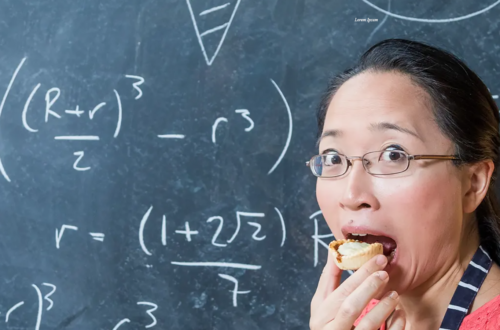Yvette d’Entremont and Michelle Voillot
Math was my (Yvette’s) favourite subject in school. It was logical and practical, and I was good at it. I now realize that I was good at applying the rules and procedures necessary to solve the problem. However, very few of my classmates felt as I did.
Many students perceive mathematics as being difficult. Mathematics “is one of the most important subjects in schools in a modern society” (Bishop 1997), yet it remains a challenge to master. It has often been perceived as a body of facts, procedures, theorems and algorithms (Banks 1991; Bishop et al 1993). Some students grasp the meaning related to mathematical concepts, whereas others simply try to memorize what they see as a set of abstract rules (Barta, Eglash and Barkley 2014; Bishop 1997). In 1992, Teen Talk Barbie uttered the words “Math class is tough.” After backlash from women’s groups, that phrase was quickly removed from Barbie’s vocabulary. It did, however, leave the impression that “math is tough” was a common sentiment. As a young teacher, I realized that most of my students saw mathematics as abstract, difficult and not related to anything real.
An important aspect of mathematics that should be considered in mathematics instruction is culture. Culture can be defined as the beliefs, values, attitudes, customs, social relationships, art and literature that define an ethnic group (Abidi 1996; Banks 2008). In the mathematics classroom, teachers should consider the cultural backgrounds of the members of the classroom, the school and the community.
Many teachers of subjects such as mathematics and the sciences are under the impression that mathematics is a noncultural subject (Banks 2008; Dalley and d’Entremont 2004; Lee 2003). Mathematics is often taught as a set of universally accepted facts (Bishop et al 1993; D’Ambrosio 1990), leading to the perception that it is a culture-free discipline (Banks 1993; Lee 2003; Peterson and Barnes 1996; Secada 1989). Noth-ing could be further from the truth. Mathematics is not waiting to be discovered but, rather, can be constructed through culturally symbolic representations.
Acharya (2015) suggests that mathematics seems to be influenced by learners’ cultural backgrounds and that it should be connected to students’ lives and cultures. Similarly, Glanfield and Sterenberg (2020) discuss culturally responsive education in mathematics.
The purpose of this article is to demonstrate how basic mathematics is rooted in culture through the example of the cultural activity of quilting.
Culture, Teaching and Learning
My teaching career began in an Acadian school in southwest Nova Scotia. The community was rich in personal resources and practical applications: fisher-men, carpenters, women who made beautiful quilts and the Mi’kmaq who made sturdy woven baskets. Although integrating culture and school subject con-tent is not a new concept, back then I did not take advantage of the resources available to me that would have made mathematics real to my students.
D’Ambrosio (1985) uses the term ethnomathematics to describe the relationship between culture and mathematics. It is important to understand how culture relates to students and their ways of thinking and learning mathematics (D’Ambrosio 2001). The National Council of Teachers of Mathematics (NCTM 1991) Professional Standards for Teaching Mathematics highlights the importance of building connections between mathematics and students’ personal lives and cultures. Rosa and Orey (2009) have examined mathematics in a variety of cultural contexts and have concluded that mathematics cannot be culture-free, as learning is influenced by society. As Stevens, Sharp and Nelson (2001, 376) write, “When mathematics lessons are linked with personal experiences, typically, the result is that the student gains a stronger understanding of the content than if the lessons are isolated and unconnected.” Personal experiences relate to students’ multiple ways of knowing that integrate their background knowledge and home and community experiences.
The term culturally relevant pedagogy has been used to stress the importance of using home and com-munity cultural experiences to cultivate learning with understanding (Gay 2002; Ladson-Billings 1994). Gay believes that “there is a place for cultural diversity in every subject taught in schools” (p 107) and notes that “research indicates that culturally relevant examples have positive effects on the academic achievement of ethnically diverse students” (p 113). Students’ learning is influenced by their cultural backgrounds (Stylianides and Stylianides 2007). Using cultural knowledge and personal frames of reference can make learning encounters more relevant and strengthen connections to mathematics, thereby enhancing learning (Boaler 1993; Eglash 1997; Rosa and Orey 2010).
Harackiewicz, Smith and Priniski (2016) state that interest is essential to academic success. Although interventions that develop student interest matter in all educational contexts, the authors note that such interventions are most needed in academic domains that many students do not initially find interesting, as well as in domains in which student interest tends to decline over time, such as mathematics and other STEM (science, technology, engineering and mathematics) subjects. The relationship between interest and learning seems self-evident: the more interest students have in a topic, the more they are willing to learn about it (Schraw, Flowerday and Lehman 2001).
Various pedagogical approaches have been used to demonstrate the importance of the relationship between personal interest and meaningful mathematics. Wiseman et al (2020) discuss three learning opportunities that demonstrated how Indigenous and Western ways of knowing can work together. The projects took place in three Indigenous communities: the Mi’kmaq Territory in Nova Scotia, the Anishi-naabe Territory in Ontario and the Kanien’kehá:ka Territory in Quebec. The Nova Scotia project—Show Me Your Math—demonstrates the impact of making meaningful personal connections to mathematics.1
Culture, Mathematics and Motivation
Integrating culture into mathematics can be challenging. However, as Rosa and Orey (2010, 24) write,
There are evidences from research (Bishop, 1988; Boaler, 1993; Eglash, 1997; [Orey & Rosa, 2007]; Zaslavsky, 1996) that including cultural aspects in the curriculum will have long-term benefits for mathematics learners; that is, cultural aspects contribute to recognizing mathematics as part of daily life, enhancing the ability to make meaningful connections, and deepening the understanding of mathematics.
Integrating culture and content to illustrate mathematical concepts can be done by using examples, artifacts and information from various cultures (Banks 1993). Many students are not motivated to learn mathematics. However, they become motivated to learn when teaching is related to their real world and identity (Zaslavsky 2002). Activities and concepts that are personally relevant are often more interesting to students and can motivate them to learn something about a new topic (Sansone and Thoman 2005). As students’ knowledge increases, they find more value in the topic and make connections to things they al-ready know and care about. In turn, this can further trigger their curiosity and motivate them to continue learning about the topic.
Motivation drives many behaviours, including the active process of learning. Learning mathematics in a cultural context can provide motivation for students and enhance the link between school mathematics and things students can relate to (Boaler 1993). Educators and psychologists have paid increasing attention to learning with understanding as an important goal for students (Stylianides and Stylianides 2007). Fredrickson and Branigan (2001) suggest that interest can be considered a motivational tool, as interest leads to short-term exploration and, over time, to increased personal knowledge and improved cognitive abilities.
Transforming Pedagogy
As Alberta’s K–9 mathematics program of studies (Alberta Education 2007) states, students by nature are curious and want to learn. They bring their personal values and beliefs from home and community into the classroom. The references to home and com-munity in the program of studies should not be ignored, as mathematics has more meaning when integrated with culture (Wiest 2002).
A variety of cultural artifacts and expressions (such as weaving, knitting, beading, rug making and quilting) make use of mathematics. Studying the patterns in these artifacts can increase understanding of mathematical concepts.
The quilt is one of many cultural traditions and artifacts that can be used to teach a variety of mathematical concepts in a context that is motivating and interesting and that supports a connection between subject and student interests. A quilt is a cultural symbol. Whereas traditional quilts were made for practical use, modern quilts are not only practical but
also works of art. This form of artistry involves im-provisation, experimentation and creativity—and mathematics. Even a basic quilt involves tessellating patterns of geometric shapes, which requires knowl-edge of transformational geometry. (For example, determining how tessellating shapes will fit together with no gaps requires some thought.)
I made my first quilt (Figure 1) at the beginning of my teaching career. It wasn’t fancy, the pattern wasn’t complicated, and the colours were quite dull, but it was proof that I could take my place among the quilters in the family. The many quilt shows and quilting stores in Alberta indicate that quilting is not a dying pioneer art. It is, in fact, an example of cultural knowledge that is passed on to the next generation, and “the acquisition of cultural knowledge is important to all peoples” (Alberta Teachers’ Association 2016, 36).

A simple quilting pattern (as shown in Figure 2) illustrates symmetry, rotations, reflections and translations. By analyzing simple quilting designs, students can determine the lines of symmetry and the transformations involved.
Once students are familiar with the properties of symmetry and with transformations, they can analyze a variety of quilt block designs, as shown in Roscoe and Zephyrs (2016, 25).
Designing a quilt block is an excellent way to explore symmetry, tessellations and transformational geometry. Providing students with a blank 3 × 3 or 4 × 4 grid (Figure 3) and asking them to create their own design (Figure 4) allows them to put into practice the properties they have studied. Students can then explain what properties they used to create the design. The same design can look quite different in other colour combinations. Students’ creativity and their understanding of the concepts will determine the designs. Upon completion, the blocks can be dis-played together as a paper quilt. This activity allows students to practise mathematics as a quilter would.

Harackiewicz, Smith and Priniski (2016) recommend providing students with content and academic tasks that facilitate the connection between academic topics and existing student interests. Creating a quilt block design is an interesting, motivating and practical way to teach a variety of mathematical concepts, as well as encouraging creativity and mathematical investigation.
Members of the community can be an important educational resource. A community member who quilts can demonstrate quilting for students while explaining the process, the pattern, the colours and the choice of materials. The many mathematical concepts that are involved in making a quilt can be pointed out during the demonstration.
This same activity can be done using other arti-facts, such as the Ukrainian pysanka, the Métis sash or the French Canadian ceinture fléchée. Teachers can incorporate these activities into the mathematics curriculum.
Conclusion
Many students and teachers believe that no connection exists between mathematics and culture, but nothing is further from the truth.


Studies have demonstrated that culture is a vital part of mathematics (Eckermann 1994; Massarwe, Verner and Bshouty 2012; Zaslavsky 1996, 1998). Mathematical activities that reflect cultural traditions can be used to teach mathematical concepts, and mathematics knowledge is inherently tied to cultural practices (Nasir, Hand and Taylor 2008). The education that students receive at home and in their com-munities greatly influences how they learn, and they bring those values and beliefs to school.
Integrating familiar objects and contexts in the teaching of mathematics can facilitate learning. Mathematics can best be understood when it is experienced in the context in which it is used. Gay (2002, 106) concludes that “when academic knowledge and skills are situated within the lived experience and frames of reference of students, they are more person-ally meaningful, have higher interest appeal, and are learned more easily and thoroughly.”
Promoting interest in the classroom contributes to a more motivated and engaged learning experience, as interest is a powerful source of motivation that energizes learning (Harackiewicz, Smith and Priniski 2016). Interest has been cited as a central component of motivation in learning, and interest in activities can be developed through finding meaning and value in those activities (Hidi and Renninger 2006).
Relating concepts and culture helps students dis-cover relationships between mathematics, the real world and the history of various cultures (not only their own). This creates a learning environment that is interesting and motivating. To create and maintain a culturally relevant pedagogy that reflects students’ cultures, teachers must continually re-examine their pedagogical practices and strategies.
Note
- Show Me Your Math, https://showmeyourmath.ca (accessed September 29, 2021).
Yvette d’Entremont, PhD, is a professor emerita at the Campus Saint-Jean, University of Alberta. Michelle Voillot, MC, is the assistant director of the American Institute for Behavioral Research and Technology, in San Diego, California.
References
Abidi, A H S. 1996. “Editorial.” Makerere University Newsletter 26: 1–2. Kampala, Uganda: Makerere University. Acharya, B R. 2015. “Relevance of Primary Level Mathematics Education in Nepal: A Cultural Perspective.” PhD dissertation, Tribhuvan University.
Alberta Education. 2007. Mathematics Kindergarten to Grade 9. Edmonton, Alta: Alberta Education. Also available at https://education.alberta.ca/media/3115252/2016_k_to_9_math_pos.pdf (accessed September 29, 2021).
Alberta Teachers’ Association (ATA). 2016. Education Is Our Buffalo: A Teachers’ Resource for First Nations, Métis and Inuit Education in Alberta. Edmonton, Alta: ATA.
Banks, J A. 1991. “A Curriculum for Empowerment, Action, and Change.” In Empowerment Through Multicultural Education, ed C E Sleeter, 125–41. Albany, NY: State University of New York (SUNY) Press.
———. 1993. “Multicultural Education: Historical Development, Dimensions, and Practice.” Review of Research in Education 19, no 1 (January): 3–49.
———. 2008. An Introduction to Multicultural Education. 4th ed. Boston, Mass: Pearson Education.
Barta, J, R Eglash and C Barkley. 2014. Math Is a Verb: Activities and Lessons from Cultures Around the World. Reston, Va: National Council of Teachers of Mathematics (NCTM).
Bishop, A J. 1988. Mathematics Enculturation: A Cultural Perspective on Mathematics Education. Dordrecht, Netherlands: Kluwer. Cited in Rosa and Orey 2010, 24.
———. 1997. “The Relationship Between Mathematics Education and Culture.” Opening address delivered at the Iranian Mathematics Education Conference, Kermanshah, Iran, August. Also available at www.researchgate.net/profile/Alan-Bishop-3/publication/255590052_the_relationship_between_mathematics_education_and_culture/links/549a5a1f0cf2b8037135936a/the-relationship-between-mathematics-education-and-culture.pdf (accessed September 29, 2021).
Bishop, A J, K Hart, S Lerman and T Nunes. 1993. Significant Influences on Children’s Learning of Mathematics. Science and Technology Education Document Series No 47. Paris: United Nations Educational, Scientific and Cultural Organization (UNESCO).
Boaler, J. 1993. “The Role of Contexts in the Mathematics Classroom: Do They Make Mathematics More ‘Real’?” For the Learning of Mathematics 13, no 2 (June): 12–17. Also available at https://flm-journal.org/Articles/5456B6E86646C379524F75BCA9D7EE.pdf (accessed September 29, 2021).
Dalley, P, and Y d’Entremont. 2004. Identité et appartenance en milieu scolaire : Guide à l’intention des concepteurs de programmes. Halifax, NS: Conseil atlantique des ministres de l’Éducation et de la Formation.
D’Ambrosio, U. 1985. “Ethnomathematics and Its Place in the History and Pedagogy of Mathematics.” For the Learning of Mathematics 5, no 1 (February): 44–48. Also available at https://flm-journal.org/Articles/72AAA4C74C1AA8F2ADBC208D7E391C.pdf (accessed September 29, 2021).
———. 1990. “The Role of Mathematics Education in Building a Democratic and Just Society.” For the Learning of Mathematics 10, no 3 (November): 20–23. Also available at https://flm-journal.org/Articles/4484843CAD6BAAD947FB3848B341B4.pdf (accessed September 29, 2021).
———. 2001. “What Is Ethnomathematics, and How Can It Help Children in Schools?” Teaching Children Mathematics 7, no 6 (February): 308–10.
Eckermann, A-K. 1994. One Classroom, Many Cultures: Teaching Strategies for Culturally Different Children. Sydney: Allen & Unwin.
Eglash, R. 1997. “When Math Worlds Collide: Intention and Invention in Ethnomathematics.” Science, Technology, and Human Values 22, no 1 (January): 79–97.
Fredrickson, B L, and C Branigan. 2001. “Positive Emotions.” In Emotions: Current Issues and Future Directions, ed T J Mayne and G A Bonanno, 123–51. New York: Guilford.
Gay, G. 2002. “Preparing for Culturally Responsive Teaching.” Journal of Teacher Education 53, no 2 (March): 106–16.
Glanfield, F, and G Sterenberg. 2020. “Understanding the Landscape of Culturally Responsive Education Within a Community- Driven Mathematics Education Research Project.” In Living Culturally Responsive Mathematics Education with/in Indigenous Communities, ed C Nicol, J A Q Q Xiiem, F Glanfield and A J S Dawson, 71–90. Leiden, Netherlands: Brill.
Harackiewicz, J M, J L Smith and S J Priniski. 2016. “Interest Matters: The Importance of Promoting Interest in Education.” Policy Insights from the Behavioral and Brain Sciences 3, no 2 (October): 220–27.
Hidi, S, and K A Renninger. 2006. “The Four-Phase Model of Interest Development.” Educational Psychologist 41, no 2: 111–27.
Ladson-Billings, G. 1994. The Dreamkeepers: Successful Teachers of African American Children. San Francisco: Jossey-Bass.
Lee, O. 2003. “Equity for Linguistically and Culturally Diverse Students in Science Education: Recommendations for a Research Agenda.” Teachers College Record 105, no 3: 465–89. Also available at www.tcrecord.org/content.asp?contentid=11114 (accessed September 29, 2021).
Massarwe, K, I Verner and D Bshouty. 2012. “Ethnomathematics and Multi-cultural Education: Analysis and Construction of Geometric Ornaments.” Journal of Mathematics and Culture 6, no 1 (March): 344–60.
Nasir, N S, V Hand and E V Taylor. 2008. “Culture and Mathematics in School: Boundaries Between ‘Cultural’ and ‘Domain’
Knowledge in the Mathematics Classroom and Beyond.” Review of Research in Education 32 (February): 187–240. National Council of Teachers of Mathematics (NCTM). 1991. Professional Standards for Teaching Mathematics. Reston, Va: NCTM.
Orey, D, and M Rosa. 2007. “Cultural Assertions and Challenges Towards Pedagogical Action of an Ethnomathematics Program.” For the Learning of Mathematics 27, no 1 (March): 10–16. Also available at https://flm-journal.org/Articles/7E5EFFA4B24CB97110973C060200F3.pdf (accessed September 29, 2021). Cited in Rosa and Orey 2010, 24.
Peterson, P L, and C Barnes. 1996. “Learning Together: The Challenge of Mathematics, Equity, and Leadership.” Phi Delta Kappan 77, no 7 (March): 485–91.
Rosa, M, and D C Orey. 2009. “Challenges Faced by Multicultural and Multilingual Schools in the United States: The Case of Mathematics.” La Salle—Revista de Educação Ciência e Cultura 14, no 1: 29–44.
———. 2010. “Culturally Relevant Pedagogy: An Ethnomathematical Approach.” Horizontes 28, no 1 (January/ June): 19–31. Also available at www.repositorio.ufop.br/bitstream/123456789/1774/1/ARTIGO_CulturallyRelevantPedagogy.pdf (accessed September 29, 2021).
Roscoe, M B, and J Zephyrs. 2016. “Quilt Block Symmetries.” The Variable 1, no 7 (October): 19–29. Also available at http://smts.ca/wp-content/uploads/2016/04/The-Variable-2016-October.pdf (accessed September 29, 2021).
Sansone, C, and D B Thoman. 2005. “Interest as the Missing Motivator in Self-Regulation.” European Psychologist 10, no 3 (September): 175–86.
Schraw, G, T Flowerday and S Lehman. 2001. “Increasing Situational Interest in the Classroom.” Educational Psychology Review 13, no 3 (September): 211–24.
Secada, W G. 1989. “Educational Equity and Equality of Education: An Alternative Conception.” In Equity in Education, ed W G Secada, 68–88. Philadelphia: Falmer.
Stevens, A C, J M Sharp and B Nelson. 2001. “The Intersection of Two Unlikely Worlds: Ratios and Drums.” Teaching Children Mathematics 7, no 6 (February): 376–83.
Stylianides, A J, and G J Stylianides. 2007. “Learning Mathematics with Understanding: A Critical Consideration of the Learning Principle in the Principles and Standards for School Mathematics.” The Mathematics Enthusiast 4, no 1 (February): 103–14. Also available at https://scholarworks.umt.edu/tme/vol4/iss1/8/ (accessed September 29, 2021).
Wiest, L R. 2002. “Multicultural Mathematics Instruction: Approaches and Resources.” Teaching Children Mathematics 9, no 1 (September): 49–55.
Wiseman, D, L L Borden, R Beatty, L Jao and E Carter. 2020. “Whole-some Artifacts: (STEM) Teaching and Learning Emerging from and Contributing to Community.” Canadian Journal of Science, Mathematics and Technology Education 20, no 2 (June): 264–80.
Zaslavsky, C. 1996. The Multicultural Math Classroom: Bringing in the World. Portsmouth, NH: Heinemann.
———. 1998. Math Games and Activities from Around the World. Chicago: Chicago Review Press.
———. 2002. “Exploring World Cultures in Math Class.” Educational Leadership 60, no 2 (October): 66–69. Also available at www.ascd.org/el/articles/exploring-world-cultures-in-mathclass (accessed September 29, 2021).






